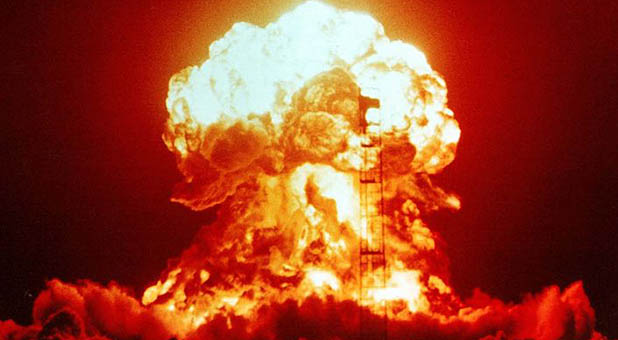5 Things You Didn’t Know About Nuclear Weapons
The current presidential election has once again brought to the fore a question we ask every electoral cycle: Which candidate can be most trusted with nuclear weapons?
The consideration given that question, though, is rather modest relative to its importance. Indeed, for those who are concerned about ordered liberty there are few questions more important than who should be in charge of the most powerful arsenal of weapons on earth. We are giving a single individual unprecedented control over weaponry that could disrupt the lives and liberty of billions of people across the planet.
In thinking about the issue, there are a range of moral considerations we must think about carefully. But we should also be armed with basic facts, which is why we should know these five basic facts about nuclear weapons:
1. A nuclear weapon is an explosive device that produces destructive energy by splitting the nucleus of an atom from material capable of sustaining a nuclear fission chain reaction. The two primary types of nuclear bombs use either fission (the process of splitting the nucleus of an atom into two or more smaller nuclei) or a two-stage process that uses fission and fusion (the process by which multiple hydrogen nuclei join together to form a heavier nucleus). Those that use fission alone are often referred to as “atomic bombs” (A-bombs) while those that use fission and fusion are called “hydrogen bombs” (H-bombs) or thermonuclear weapons. There are three types of nuclear weapons based on the material—hydrogen, plutonium, uranium—used to create the nuclear fission reaction.
2. The destructive energy of nuclear weapons, called the explosive yield, is measured in TNT equivalent, usually in kilotons (kt—thousands of tons of TNT) or megatons (Mt—millions of tons of TNT). The bomb dropped on Hiroshima was approximately 13 to 18 kt, while the bomb used on Nagasaki was 20 to 22 kt. The most powerful nuclear weapon ever detonated was Tsar Bomba, a hydrogen bomb tested by the Soviet Union in 1961. The bomb had a yield of 50,000 kt (50 Mt)—about 4,000 times more energy that the bomb used on Hiroshima—and had a destructive radius of 15 miles. (You can see a video of the testing here.) The largest nuclear weapon currently in the U.S. stockpile, the B83, has a yield of 1,200 kt (1.2 Mt).
3. Apart from the explosive yield, much of the danger of nuclear weapons comes from radioactive fallout. Radioactive material can attach itself to dirt and other debris during the explosion and settle over a broad area. For survivors of a nuclear blast, this radiation hazard could pose a danger for months or years after the attack. In the 1950s, fallout shelters were created throughout the United States to provide shelter after an attack. Although they would not provide protection from a direct hit, fallout shelters would allow people to escape exposure while the short-lived radiation expended itself.
4. The Treaty on the Non-Proliferation of Nuclear Weapons of 1970 (aka the Non-Proliferation Treaty or NPT) recognizes five states as nuclear-weapon states: the United States, Russia, the United Kingdom, France, and China (these are also, not coincidently, the five permanent members of the United Nations Security Council). India and Pakistan have also tested nuclear devices. Israel is believed to have nuclear weapons, though they have never admitted to it or tested them. North Korea is believed to have nuclear bombs but no missiles that can deliver them. The U.S. Defense Department maintains about 4,760 nuclear warheads, according to estimates by the Bulletin of the Atomic Scientists. Of this number, they estimate that approximately 2,080 warheads are deployed while 2,680 warheads are in storage. In addition to the warheads in the Defense Department stockpile, approximately 2,340 retired but still intact warheads are in storage under the custody of the Energy Department and awaiting dismantlement, for a total US inventory of roughly 7,100 warheads.
5. As the commander in chief of the U.S. armed forces, the president maintains sole authority to authorize the launch of nuclear weapons. Military doctrine recommends that the president consult with senior commanders in making a decision to employ nuclear weapons, but he is not bound to do so. The president is accompanied at all times by a military officer carrying a briefcase that contains a secure satellite communication radio and handset, the nuclear launch codes known as the “Gold Codes,” and the President’s Decision Book on options for using nuclear weapons. This briefcase is officially known as the “president’s emergency satchel,” but it is often referred to as the “football.” (According to Smithsonian Magazine, it acquired its name from an early nuclear war plan code-named “Dropkick.” “Dropkick” needed a “football” in order to be put into effect.) The president carries a personal identification code—called “the biscuit”—which is needed to confirm nuclear launches. (Bill Clinton reportedly misplaced his “biscuit” for several months while in office.)
Joe Carter is a Senior Editor at the Acton Institute. Joe also serves as an editor at the The Gospel Coalition, a communications specialist for the Ethics and Religious Liberty Commission of the Southern Baptist Convention, and as an adjunct professor of journalism at Patrick Henry College. He is the editor of the NIV Lifehacks Bible and co-author of How to Argue like Jesus: Learning Persuasion from History’s Greatest Communicator (Crossway).














































